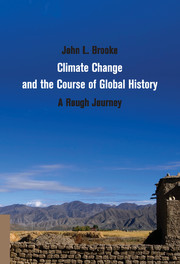Book contents
- Frontmatter
- Dedication
- Contents
- List of Figures and Tables
- Acknowledgments
- List of Abbreviations
- Introduction
- Part I Evolution and Earth Systems
- Part II Domestication, Agriculture, and the Rise of the State
- Part III Ancient and Medieval Agrarian Societies
- 6 Stasis and Growth in the Epoch of Agrarian Empires
- 7 Optimum and Crisis in Early Civilizations, 3000–500 BC
- 8 A Global Antiquity, 500 BC–AD 542
- 9 The Global Dark and Middle Ages, AD 542–1350
- Part IV Into the Modern Condition
- Data Bibliography: Full Citations for Data Used in Figures and Tables
- Index
- References
6 - Stasis and Growth in the Epoch of Agrarian Empires
Published online by Cambridge University Press: 05 August 2014
- Frontmatter
- Dedication
- Contents
- List of Figures and Tables
- Acknowledgments
- List of Abbreviations
- Introduction
- Part I Evolution and Earth Systems
- Part II Domestication, Agriculture, and the Rise of the State
- Part III Ancient and Medieval Agrarian Societies
- 6 Stasis and Growth in the Epoch of Agrarian Empires
- 7 Optimum and Crisis in Early Civilizations, 3000–500 BC
- 8 A Global Antiquity, 500 BC–AD 542
- 9 The Global Dark and Middle Ages, AD 542–1350
- Part IV Into the Modern Condition
- Data Bibliography: Full Citations for Data Used in Figures and Tables
- Index
- References
Summary
Getting Ahead, Running in Place, Falling Behind
Around 3000 BC, driven by the abrupt final crisis of the Mid-Holocene transition, the state organization of society suddenly began to emerge in particular locations in the Old World, first in Mesopotamia and Egypt, then the Indus Valley, and the Yellow River Valley of China. Now, in the early twenty-first century, we look back over 5,000 years of “history,” defined as such by the bureaucratic organization of the state and the writing systems that support it. Even within those 5,000 years, however, our modern condition emerged only yesterday, grounded in an industrial transition to fossil fuel that began only 300 years ago, on a world economy of center and periphery that emerged only 500 years ago with the rise and spread of early modern European empires. These 500 years encompass the early modern and modern transformations that will be the subject of Part IV of this book. Part III examines the forty-four centuries that intervened between the rise of the state and the opening of the crises that would lead eventually to global modernity. More precisely, I close my account of premodernity around AD 1350, after New World societies had been severely impacted by medieval droughts and as Old World societies were feeling the first manifestations of the Little Ice Age and facing the devastation of the grievous mortality of the Black Death.
What then of the ancient and medieval worlds that occupied the global stage between “prehistory” and “modernity”? The rise of modernity, with its global reach, massive population and economic growth, and energy revolutions can make these worlds look paltry by comparison, a long, flat-line epoch of stagnant agrarian economies governed by unchanging autocratic states. From this perspective, ancient and medieval societies simply were bound in a “Malthusian trap” of the limits of the organic economy. Economic growth was limited to either additive territorial expansion of growing populations to new territories – increasingly by imperial violence – or by an equally additive intensification of commerce, labor, and organic technologies, so-called Smithian growth.
- Type
- Chapter
- Information
- Climate Change and the Course of Global HistoryA Rough Journey, pp. 261 - 287Publisher: Cambridge University PressPrint publication year: 2014

